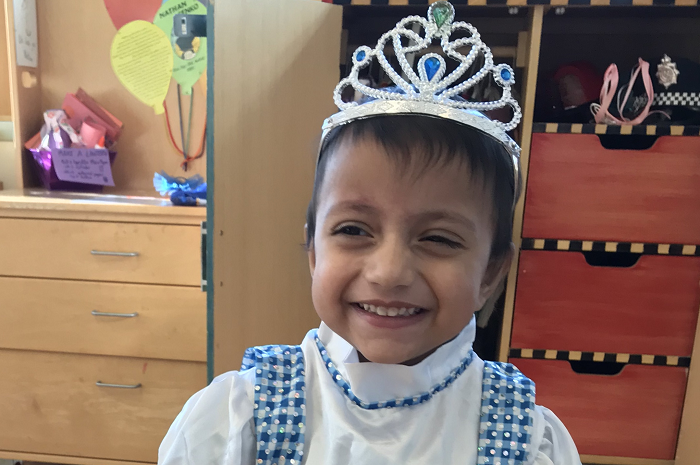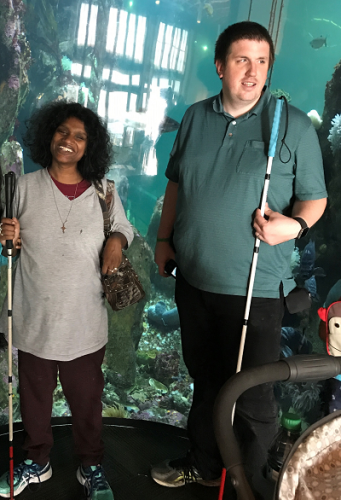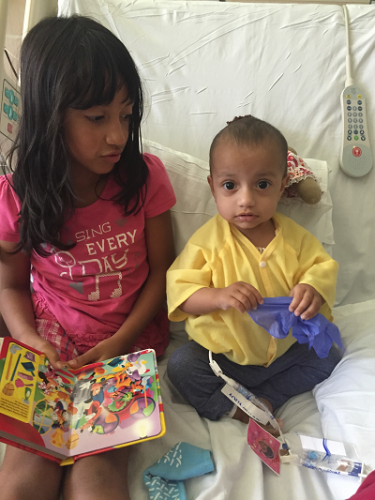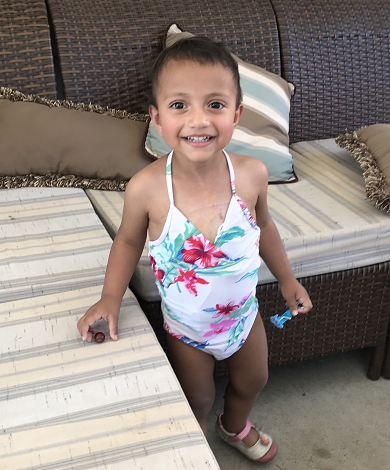
For many parents, caring for a child with a serious medical condition can have its challenges.
For Hailee and Ray Hughes, the challenge of caring for their 3-year-old daughter, Ruth, who has a rare gastrointestinal disorder, meant learning complicated skills like how to maintain Ruth’s nutritional needs intravenously through a tube connected to her chest.
“It definitely wasn’t easy at first,” said Hughes. “There was a lot to learn and we wanted to safely care for our daughter in the best way we could.”
Learning the proper techniques involved in Ruth’s care was one thing, but doing it with partial to no vision was another.
“I was born blind and Ray is partially sighted,” said Hughes. “However, we’ve never let that interfere with parenting our four children.”
Through the process, Hughes and her husband fortunately had guidance and support from Seattle Children’s Intestinal Rehabilitation Program team who connected them with resources that helped train them on the proper techniques that would allow them to manage Ruth’s medical needs from the comfort of their home.
“There were many people who thought we weren’t capable of caring for her,” said Hughes, “but we fought to prove that it was possible.”
A special feeling leads to a frightening discovery

Nothing seemed out of the ordinary when Hughes gave birth to Ruth, her third child.
“Although she was considered a borderline preemie when I delivered her, Ruth was born healthy,” said Hughes. “Yet, I had this feeling there was something special about her.”
Over the next few months, Hughes noticed Ruth acted somewhat sluggish at times, but it didn’t seem too concerning at first since she was eating and sleeping normally.
“She really seemed to enjoy eating during the first few months, then all of a sudden there were times when she wouldn’t eat,” said Hughes. “Initially I thought she just didn’t like the type of food I was giving her.”
By the time Ruth was 1-and-a-half years old, her lack of appetite seemed to be getting worse and she wasn’t gaining weight.
“She was extremely lethargic,” said Hughes. “It was then I knew she needed to be seen by a doctor as soon as possible.”
Hughes, accompanied by her mother-in-law, took Ruth to the nearest emergency room from their hometown of Vancouver, Washington.
Ruth was admitted to the hospital as doctors worked to find a diagnosis. Over the next few months, the Hughes faced major obstacles from those doubting her and her husband’s ability to care for their daughter due to their limited vision.
“We fought hard to show them how committed we were to Ruth’s health,” said Hughes. “Eventually they realized we were capable of caring for her and I couldn’t have been more relieved.”
Proof that it’s possible

With doctors still unable to pinpoint Ruth’s illness, she was transferred 100 miles north to Seattle Children’s for further evaluation.
“We received warm greetings as soon as we arrived at the hospital,” said Hughes. “It was such a welcoming atmosphere, and after everything we had been through at that point, I felt a sense of hope.”
After Ruth underwent thorough testing, a diagnosis was finally found.
“Ruth was diagnosed with a rare disorder called chronic intestinal pseudo-obstruction,” said Dr. Danielle Wendel, a gastroenterologist from Seattle Children’s Gastroenterology and Hepatology Clinic and Intestinal Rehabilitation Program. “It is caused by a problem with how the muscles and/or nerves in the intestines work, affecting motility, which is the movement of food through the digestive tract.”
At first, Hughes didn’t want believe her daughter was suffering with such a serious condition because she was fearful of the unknown. But she found comfort in the care Ruth was receiving.
“Once I learned more about her condition, and that Seattle Children’s had experience in treating patients like Ruth, I felt confident that we could get through this,” said Hughes.
As the family remained in the hospital for the next five months, Ruth tried various types of treatment to try to stabilize her health so her family could eventually take her home.
“We found that giving Ruth total parenteral nutrition, or TPN, worked well for her,” said Wendel. “TPN is administered intravenously to supply nutrition to those who cannot absorb or consume the nutrients they need. It is something that can be managed at home, but requires careful training, which we discussed with her parents.”
While it seemed like a difficult undertaking, Hughes and her husband knew it was worth trying.
“It was definitely a first for us in training Ruth’s parents,” said Wendel. “We were unsure if we could make it work, but her parents were so committed to learning.”
It took months of training, practice and supervision for Hughes and her husband to become familiarized with the techniques.
“We learned about the different parts and how they connected,” said Hughes. “Because Ray is partially sighted, he would practice inserting the TPN syringe into the IV, and I would sterilize the area.”
With hard work and memorization, they were able to get the process down to a tee.
“The family passed the training with flying colors and were finally able to take Ruth home,” said Wendel. “I was really proud of them and what they were able to accomplish.”
A new vision of care

Back home, Hughes and her husband established a care routine for Ruth with help from a home nurse and family members that lived close by.
“Every night Ray will prepare the TPN supplies using special electronic glasses that allow him to have 20/20 vision,” said Hughes. “I help with some of the minimal tasks because her safety is always at the top of my mind.”
While it can be a challenge for a 3-year-old to understand why they need a feeding tube, Hughes has been working with Ruth to help answer all of her ‘whys,’ as Ruth will likely be on TPN for the rest of her life due to the severity of her condition.
“We’ve developed a special bond through all of this and I learn so much from her every day,” said Hughes.
Ruth’s health is currently stable and she is thriving. She enjoys playing in the park and watching movies with her three siblings, and is a big fan of the movie Frozen.
“We continue to work with her parents very closely, and they have been so wonderful,” said Wendel. “While the future is not totally clear for Ruth, based on how well things have gone so far at home, I’m optimistic they can continue to give her the best care.”
Hughes wants to teach Ruth that just because she’s different, it’s doesn’t mean she’s incapable of living a normal life.
“I’ve learned to not let my blindness limit me in what I can do,” said Hughes. “I want Ruth to know she can do the same.”

